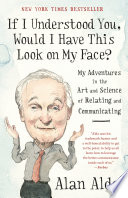

In 'If I Understood You, Would I Have This Look on My Face?', the author underscores the critical role empathy plays in effective communication. Empathy is not just about feeling for someone but understanding their perspective and emotional state. The book illustrates how often conversations fail because we are not truly listening or trying to understand the other person. By fostering empathy, individuals can enhance their relationships, both personally and professionally. The author provides anecdotes and research that demonstrate the positive outcomes of empathetic communication, such as improved collaboration, conflict resolution, and trust-building. This idea encourages readers to practice active listening and to engage with others in a way that validates their experiences and emotions. The emphasis on empathy serves as a foundation for more meaningful interactions and can lead to more productive discussions in various settings, from workplaces to personal relationships.
Continue readingThe book discusses how assumptions can derail conversations and lead to misunderstandings. Often, we assume we know what others are thinking or feeling based on our biases or previous experiences. This can lead to miscommunication and conflict. The author emphasizes the need to challenge these assumptions and to seek clarification instead. By doing so, we open the door to more honest and constructive dialogue. The book provides examples of how assumptions can lead to detrimental outcomes in both personal and professional contexts. It encourages readers to adopt a mindset of curiosity, asking questions and seeking to understand rather than jumping to conclusions. This idea is particularly relevant in diverse environments where different backgrounds and perspectives can create misunderstandings if assumptions are made without verification.
Continue readingNonverbal cues play a significant role in communication, often conveying more than words themselves. The author delves into the complexities of body language, facial expressions, and tone of voice, explaining how these elements can enhance or undermine verbal messages. For instance, a person's posture or eye contact can indicate engagement or disinterest, affecting how messages are received. The book highlights the importance of being aware of one’s own nonverbal signals and interpreting those of others accurately. It provides practical tips for improving nonverbal communication skills, such as being mindful of body language and practicing active listening. Understanding nonverbal communication can greatly improve interpersonal interactions and help individuals navigate social situations more effectively, making this a vital skill in both personal and professional realms.
Continue readingContext is crucial in shaping how messages are interpreted. The author argues that understanding the context in which communication occurs can dramatically alter its meaning. This includes considering the physical environment, cultural background, and the emotional state of the participants. The book provides examples of how miscommunication can arise when context is ignored, such as in cross-cultural interactions where different norms and values can lead to misunderstandings. By being attuned to context, individuals can tailor their communication strategies to better fit the situation and the audience, leading to more effective exchanges. This idea encourages readers to think critically about the circumstances surrounding their conversations and to adapt their approaches accordingly, fostering greater understanding and connection.
Continue readingFeedback is a crucial component of effective communication and personal development. The author discusses how giving and receiving feedback can be challenging but is essential for growth. Constructive feedback helps individuals understand their strengths and areas for improvement, while also fostering a culture of open communication. The book provides strategies for delivering feedback in a way that is respectful and constructive, as well as tips for receiving feedback without becoming defensive. It emphasizes the importance of viewing feedback as an opportunity for learning rather than criticism. By normalizing feedback in both personal and professional settings, individuals can create environments where continuous improvement is encouraged and valued.
Continue readingStorytelling is presented as a powerful tool for communication, capable of engaging audiences and conveying complex ideas in relatable ways. The author explains how stories can evoke emotions, create connections, and facilitate understanding. By framing messages within a narrative, individuals can make their points more compelling and memorable. The book offers guidance on how to craft effective stories, focusing on elements such as character, conflict, and resolution. It also discusses the role of authenticity in storytelling, stressing that genuine narratives resonate more deeply with audiences. This idea encourages readers to harness the power of storytelling in their communication, whether in presentations, conversations, or written formats, to enhance engagement and impact.
Continue readingThe author emphasizes that communication is not a static skill but one that requires ongoing development. The book encourages readers to view communication as a dynamic process that evolves with experience and practice. It highlights the importance of self-reflection in identifying areas for improvement and seeking opportunities for learning, whether through formal education, workshops, or everyday interactions. The idea is that by committing to continuous learning, individuals can refine their communication skills, adapt to new challenges, and build stronger relationships. The author provides resources and strategies for readers to engage in this lifelong learning journey, reinforcing the notion that effective communication is a vital skill that can always be enhanced.
Continue reading